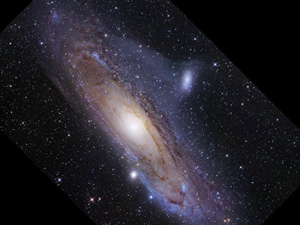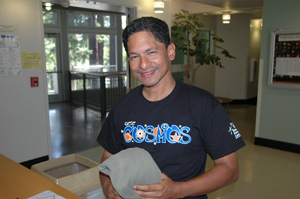Thousands of high school students spend summer vacations flipping cheeseburgers or saying "paper or plastic?" all day long.
And then there's Michelle Deng, who is only 16 years old, but if you ask her how she's spending her vacation, she'll explain that she's "using the spectra of stars to extract information about their chemical abundances."
If you ask Anirudh Suvarna, 16, he'll talk about his adventures "analyzing velocities and the brightness profile of a simulated galaxy."
Deng, who attends the Harker School in San Jose, and Suvarna, who attends Monta Vista High School in Cupertino, are part of a select group of brainy, super-motivated high school students taking part in a UC Santa Cruz summer program that helps young people delve deeply into research in the physical sciences with professional mentors to guide them.
This internship pairs high-achieving, science- and math-oriented Bay Area teens with post-docs, grad students, and faculty who help them explore topics ranging from the formation of nearby and distant galaxies to the chemical properties of coatings on telescope lenses and nanochemistry.
This physical sciences internship for high school students is so new, it doesn't have a cute, easy-to-remember acronym. But this prestigious, nameless internship has grown exponentially in its two years of existence. Last year, only three students were chosen to take part. All three would go on to earn top honors in national science competitions.
This year, 15 students are participating.
Two of the 15 students are working with astronomy/astrophysics faculty mentor Sandy Faber and two postdoctoral researchers, Kamson Lai and Dale Kocevski. Three other high school students are working in the chemistry department, one in Professor Shaowei Chen's lab and two in Professor Yat Li's lab.
Two high-school students are working in the Lick Observatory Shops on astronomical instrumentation under the mentorship of Lick Observatory technical staff David Cowley and David Hilyard.
Astronomy professor Puragra Guhathakurta, affectionately known to his students as "Raja," is the internship's founder and program coordinator. He mentors eight of the students, all of whom are studying galaxies. The students' immediate supervisors are former and current graduate students, undergraduates, and post-docs who have studied with Guhathakurta.
Guhathakurta started up the program when he noticed that the Bay Area was rich in high school internships for medicine and biology, but had fewer options for students considering careers in the physical sciences.
The application process is competitive--the students must get letters of recommendation, prepare an essay, and rank at the top of their class in physical sciences. But his rapport with the selected students is easy, friendly, and informal.
They like to joke around with him and rib him about his extremely busy schedule, which inspired them to make up a batch of T-shirts saying, "WHERE'S RAJA?"
Guhathakurta got a chuckle out of the shirts, but he said that it's no accident that the interns are often working on projects on their own.
"I'm not the kind of mentor who hovers over my students," he said. "I give them the breathing room to figure it out on their own."
The various projects sound almost impossibly technical and complex, but the students, who have strong backgrounds in chemistry and physics, are diving right in. Annie Cardinal, 16, a student at Castilleja School in Palo Alto, is working on a JavaScript program that enables astronomers to generate the velocities of stars by simulating the structure and dynamics of the Andromeda Galaxy simply by plugging in their coordinates.
Cardinal decided to apply for this internship when Guhathakurta spoke at her high school about "galaxy cannibalism." This is the process by which smaller galaxies get destroyed by, and incorporated into, larger galaxies. Individual stars in the galaxy don't get destroyed in this process. But galaxy cannibalism can disrupt the structure of the smaller galaxy, and can even cause individual stars to get "orphaned."
Cardinal, who commutes to campus three to four times a week from Palo Alto, first became interested in astronomy because of science fiction shows, movies and books "including the good old Hitchhiker's Guide to the Galaxy. What's the meaning of life, the universe and everything?"
"I've always thought that nebulae are really beautiful," she continued. "You kind of forget how big they are, how insignificant we are on this little planet."
For Cardinal, the missing piece was technical training outside the classroom, which she's now getting at UCSC. She said the program has expanded her understanding of astronomy as a career. "I thought this was a good opportunity to see if astronomy was something I want to pursue."
The summer will conclude with a final presentation scheduled for August 21. About 75 people are expected to show up. Students will present on a wide range of topics in 15 presentations. One of them will present her findings about galaxies that have "survived" the process of galaxy cannibalism. Another is studying the chemical properties of stars in the Milky Way.
Guhathakurta said the presentations will be geared toward members of the general public who don't necessarily have formal training in research in the physical sciences. He said that it is very important for scientists to convey their findings in laymen terms if they want to have a lasting impact.
"It must be accessible to everyone," he said. "The audience will be coming in completely cold."





